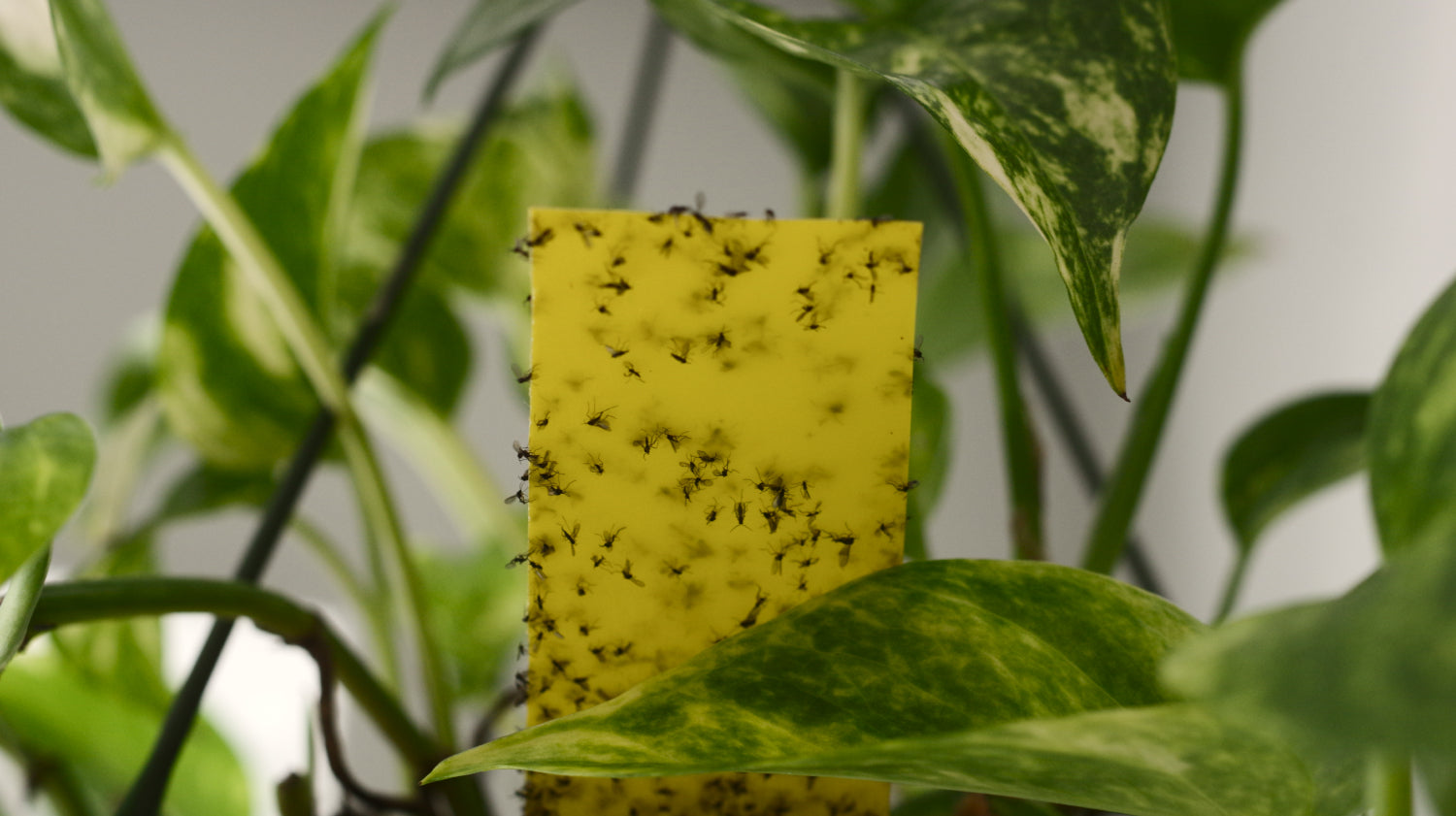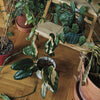The most common pests of houseplants
Uninvited guests or everything you need to know about pests
The biggest fear of houseplant growers is sad housemaids. Shriveled leaves hanging to the ground, spotted or yellowed spots on the leaves - simply a disaster. The first thing that goes through our heads is: "it must definitely be poured over!" However, this is not always true. In the following text, we will present you with some basic information about pests of houseplants, how to recognize them and how to deal with them and protect your houseplants from destruction!
The most common pest control methods
There are several types of pests, each of which requires a slightly different method of extermination. However, in general, we can present a procedure similar to first aid, which is used in pest control. It is about:
- Thoroughly wash the plant with soapy water
- Use of sprays or parasitic nematodes targeted at specific pests
A really thorough and precise washing of all parts of the plant (including leaves and stems) with soap and water can almost always be used regardless of the type of pest. It is a relatively simple and yet effective method to get rid of pests, if there were not many of them on the plant yet. We could call this procedure a herbal first aid that really works in most cases!
However, some pests are persistent and tenacious, which even soap and water won't deter. For such it is worthwhile to reach for a chemical product, most often in the form of a spray. There are many on the market - many different brands and types for all kinds of pests. So it really pays to be able to recognize and correctly identify pests.
It is advisable to repeat both presented procedures at weekly intervals until we are sure that we have successfully killed the pests.
It is also important to mention that the earlier we detect pests, the more we protect our plant treasures from destruction! The well-known saying that those who are prepared are not surprised also applies here. Timely and regular prevention also helps in the fight against pests.
Prevention, the basis of success
Pests most often breed in winter or summer. In winter, dry air from the heating suits them in domestic conditions, and in summer they multiply thanks to more frequent ventilation. However, it is clear that this is not a condition and you can come across pests almost at any time - therefore prevention really pays off. How to do it? Here are some tips.
1. Inspection: if you are choosing a new plant personally, it is advisable to inspect it thoroughly for signs of pest infestation. We always try to choose nice, healthy looking plants that have nice, healthy roots.
2. Introduction of quarantine: did you buy or get a new roommate? Congratulations, but please wait a while for her to meet the other members of her own jungle. You never know what is hiding in the soil or on a plant, because some parasites may not be visible at first glance. It is therefore recommended to introduce a quarantine system, at least for a week, but ideally for a fortnight. New or even suspicious housemaids that arouse suspicion that they might be attacked will be separated from the other flowers. It is ideal to have one free quarantine room for these needs so that "infectious" plants cannot infect the healthy ones and at the same time they do not suffer too much. Such housemaids still require the care they are used to, along with sun and watering.
Do you not have the option of quarantine? Never mind, we know the trick!
Wrap: if you don't have the option of a quarantine room, you can help yourself with a wrap! First, properly treat the attacked maid in ways that you like or have proven, and then close her in an airtight bag. Great helpers are large bags with an airtight seal. This trick not only works as insulation, but also creates something like a greenhouse, in which moisture is retained - and most pests don't need much! Such a wrap must then be checked regularly and air exchange should always be allowed for a while.
1. Regular hygiene: during the pandemic, we see warnings about washing hands more often everywhere. This is exactly what the prevention of maids calls for. By frequently wiping the leaves from dust or showering the plants with not too cold water and not too strong a stream, it keeps the plants and their natural protective barriers in good condition. Pests rarely attack plants treated in this way.
2. Checks: is it time for mass watering or are you just enjoying your green jungle? So exactly these moments are made for checking maids. Let's take a good look at the leaves from both sides, if we happen to notice something suspicious. Early action really saves us nerves, a maid and maybe even money for possible preparations.
Now that we've talked about how to prevent pest infestations in general and how to start first aid at the signs of an unwelcome invasion, it's appropriate to at least briefly imagine the most common household pests that we can encounter. So how do we recognize them and how can we grow over them?

Photo: Mourning birds caught on a glue board near a plant
Sadness
Almost everyone has encountered black, relatively annoying little flies. We can describe the weevils as the most common pests of houseplants, which in case of overpopulation mean a problem even for the growers themselves - no one likes a room full of flies. We usually bring bedbugs home in a substrate in which their larvae feed on organic matter, but unfortunately also plant roots. Houseplants then look sad, they can dry up and wither.
We can win over blackflies either by including a "dry season", when we let all plant substrates that are attacked by flies dry out properly, or we use parasitic nematodes in the fight. Adult flies can also be effectively caught using yellow glue boards . You can read more about sadniks and types of how to spin them in our article here .

Photo: Weevils creating a web around the plant
Svilushki
Weevils are one of the most resistant types of pests that multiply quickly and thus can cause considerable damage to their plant victims. These small mites grow to about half a millimeter in length, so they are often invisible to the naked eye. The most common types are white, there are also red-orange to black. They love dryness and heat, so they most often appear in winter or summer.
Aphids cluster on the leaves of the plant, which they gradually suck. Air bubbles remain in the sucked tissue after these nicks, which can give the affected leaves a silver tint. A frequent identifying sign, in addition to the rapid wilting of the plant (white, yellow or black spots on the leaves), are the small but dense spider webs that the mites leave behind.
Does your houseplant look sickly, with wilted and spotted leaves? Are there cobwebs and seemingly moving colored dots around them or at the stems? Then you have to deal with the little ones! Attention - they are most often found hidden on the underside of the leaves.
Since squibs multiply really fast and do a lot of damage, you need to be faster! We wash the plant in the affected areas, get rid of visible adults (moving dots) and in this case we advise to immediately start a counterattack with chemicals (also as a preventive measure). Suitable preparations are, for example, Vertimec or Substral Careo concentrate. To help in the fight against bedbugs, we can also call on the predatory mites Typhlodromus pyri (T-PYRI), which are one of the most effective fighters against mites! In nature, for example, ladybugs or wasps resist spider mites. In the case of using predatory mites or a purchased spray, follow the attached instructions for correct application.

Photo: Thrushes with young. Mostly from the bottom of the leaf or in the axil of the leaves
Thrips
Another sucking insect that can really torment the indoor jungle is thrips. These are small and narrow dark brown to black bugs that can grow wings as adults. Not only do they damage plants by sucking their juices, but they are also dangerous carriers of viruses that can also kill plants. Thrips mainly attack new shoots and young leaves or flowers, which causes their deformed growth. Unlike mites, these spider mites can be alerted by their droppings, which they leave behind on the leaves (tiny black spots and drops).
We can get rid of thrush with timely first aid and follow-up care. For greater efficiency, we can also use blue sticky boards - the same, but yellow ones are used to kill weevils, but thrips are attracted to the blue color. Similarly, as in the fight against bedbugs, we can deploy reinforcements in the form of predatory T-PYRI mites or use products designed to kill thrips .

Photo: Worms on the underside of a leaf
Worms
Another insect that feasts on plant juices are earthworms. These are white oval and hairy bugs. Worms are among the most resistant pests because their body is covered with a wax shield that they secrete. Worms are most often found in the hollows of leaves, in hard-to-reach places such as in the folds of leaves or even on roots underground. It is therefore not easy to notice them right away! Among the most common victims of worms are orchids, succulents and hoyas. They suck on the leaves or stems of plants and suck plant juices. At the same time, worms are among the most important pests, among other reasons, because they are used to obtain dyes used in cosmetics and the textile industry.
We can recognize worms on plants by the wilting of the plant or the honeydew they leave behind. It is a sticky liquid. However, it is much more common to notice white, cotton-like clumps on the plant, which the worms also create.
If we notice white worm larvae that do not yet have a fully developed wax shield, we can use the good old soap and water and regular spray methods on these caterpillars. However, if the worms have managed to hide and mature, their shield will likely protect them against these methods. However, we have another trick that worms don't just breathe - alcohol!
An effective method that does not require special spraying is to get rid of worms using alcohol, or by mixing alcohol with water. The liquid can be applied to the infected places on the plant either with the help of coils in the ears or with the use of an ordinary brush. On contact with alcohol, the worms simply dissolve. At the same time, the use of coils or a brush guarantees that the alcohol reaches all the places where, for example, the sprays may not reach and the worms do not escape. Substral Careo spray is also an effective dewormer.
"I first encountered worms in the dormitories, where I brought my favorite Hoya Eskimo in good faith. I found a white hairy bug on her and was scared that I didn't have any preparations with me. I found advice on alcohol on the Internet, used vodka that my roommate had in the refrigerator, and upon contact with it, the white pest simply dissolved. I was really surprised how easy it was. Fortunately, I didn't find any more worms on Hoy and the plant is in excellent health!”
After finding out that your maid is infested with worms, replanting as soon as possible is on the list after the appropriate intervention. As we wrote earlier, worms can be stored in the soil and damage the roots for some time without detection. By replanting and inspecting the roots, we avoid unpleasant surprises and "from the dead".

Photo: Buds attached to the stem of a plant
Puckles
We kept the most durable plant rogue for the end. Puklice - this is the fear of all maids. These are insects from the same order as worms, which also attach themselves to the plant and are also protected by their protective shield, which covers their entire body. We find them on houseplants as bulging round spots that are firmly stuck to the stems and leaves. Similar to worms, they also produce mead, which, among other things, enables the easier spread of various diseases. In contrast to the other mentioned pests, aphids love both warmth and moisture and can thus be found even in greenhouses!
Aphids differ from maggots in that they do not move freely around the plant, but remain stuck in place. They are thus firmly attached and protected by their carapace, which protects them from various sprays. Similar to worms, we may first notice a wilting maid. The growth deformation or the buds themselves may also appear on the plant. These armored pests are especially fond of woody plants, their favorite victim is Sophora prostrata , but as a result they will not disdain anything.
We can try to get rid of pupae by mechanically removing adults and attached individuals, for example using tweezers. If the infested area is much larger and this ant work is therefore out of the question, it is advisable to reach for contact products intended for pustules (e.g. Fast M, Mospilan or Rock Effect concentrate). In the wild, predatory species of ladybirds or wasps are the natural enemies of chrysanthemums, and titmice can also feed on them in winter. If there is nothing left, we can also try the alcohol method, which works on the worm, or the Substral Careo concentrate in the nebulizer.
Be alert!
None of us wants to meet pests in person, but once in a while an uninvited visitor just might appear. It is advisable that we come to terms with this and therefore try to conscientiously observe preventive measures and regularly inspect and check the plants (especially in winter and as soon as it starts to get warm outside again). If it doesn't work out and the pest wins the fight for the maid, keep in mind that you are neither the first nor the last to have a part of the jungle eliminated. And if you succeed, enjoy the sweet victory and perhaps reward yourself with a maid :-) !
In the next part, we will look at aphids, whiteflies, whiteflies, chvo with tokoka and more...
Author: Jana Beránková
-
Posted in
Zajímavosti a tipy





